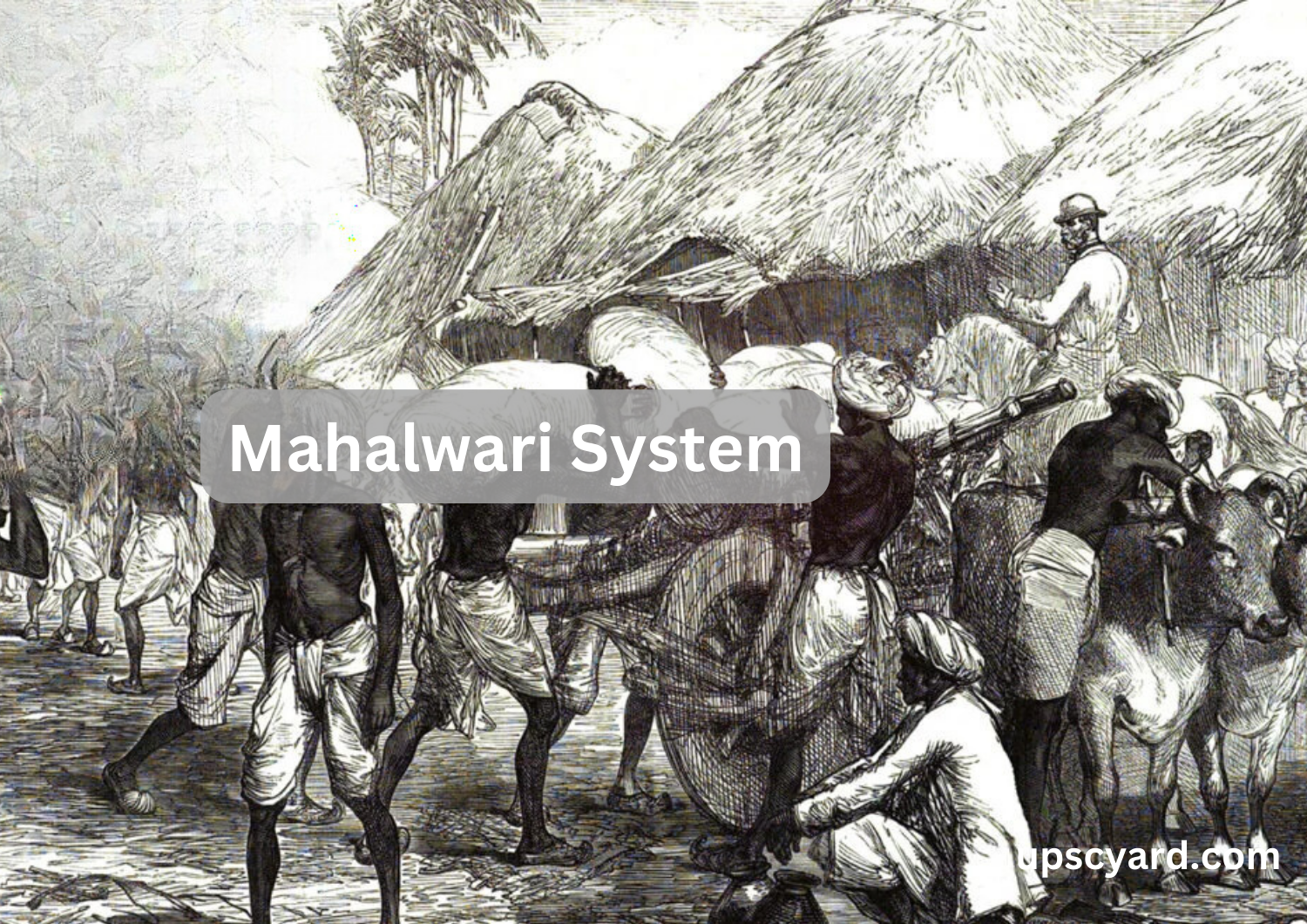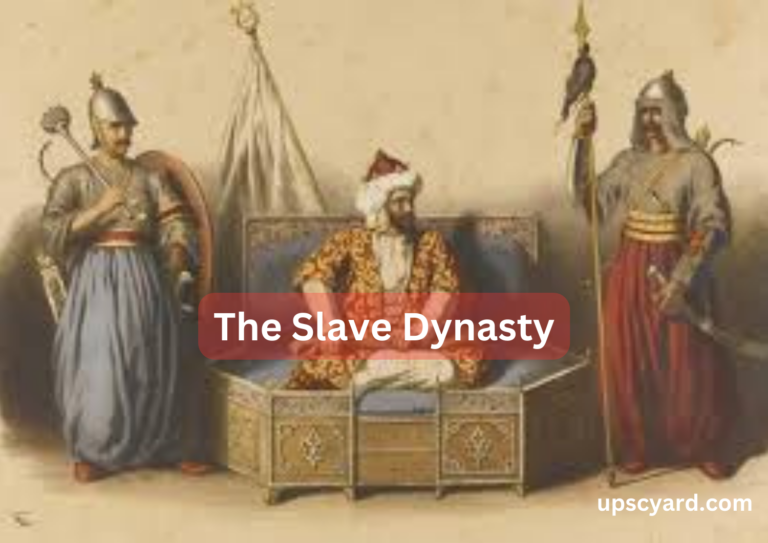Mahalwari System revised under Lord William Bentinck in 1833

Unveiling the Mahalwari System
The Genesis of Change
Lord Wellesley’s bold initiatives from 1801 to 1806 expanded British territories in North India, marking the birth of the North-Western Provinces. Originally mirroring the Bengal settlement, the British sought agreements with zamindars for a substantial land revenue. Village-wise settlements were the fallback if zamindars resisted or were absent. The intention was to make these settlements permanent, as observed in Bengal.
Revenue Surge and Resistance
Efforts to amplify revenue collection led to a drastic increase from Rs. 188 lakhs in 1803-4 to Rs. 297 lakhs by 1817-18. This surge triggered resistance from influential zamindars and rajas, who faced dispossession. Unable to meet the exorbitant demands, some zamindars lost their estates through government auctions. Consequently, direct collection from villages, mediated by the pradhan or muqaddam, became essential, giving rise to the term “mahalwari settlement.”

Evolution of Mahalwari Theory and Practice
In 1819, Holt Mackenzie proposed the idea that zamindars, appointed by the State, represented the true owners of villages. Regulation VII of 1822 mandated government officials to record cultivators’ rights and fix land payment amounts. However, implementation challenges arose. Collectors manipulated calculations to inflate government revenue, adversely affecting village communities. The 1833 decision abandoned detailed regulation, favoring a rough estimate based on the village’s paying capacity.
The Calculations Conundrum
Calculations, often inaccurate, relied on guesswork, with estimates leaning toward higher figures. The method involved assessing rents paid by tenants to determine the village’s total yield, of which 50% was to be remitted to the government. This imprecise approach inevitably led to inflated payments, showcasing the challenges embedded in the Mahalwari System.

Unraveling the Impact of Mahalwari Settlement
Restructuring Power Dynamics
The Mahalwari Settlement’s initial consequence was the reduction of areas under the control of significant taluqdars. British officers aimed for direct settlements with village zamindars, often backing them in legal disputes initiated by taluqdars. However, this support was not a benevolent gesture; it was a strategic move to maximize revenue extraction. Village zamindars, emancipated from taluqdars, found themselves subjected to heavy government taxation, leading to unforeseen challenges.
Plight of Village Zamindars
The fallout often spelled disaster for village zamindars. Reports from Aligarh highlighted the excessively burdensome land revenue, pushing Malgoozars revenue payers into insurmountable debt. Struggling to improve their conditions or manage the imposed burdens, many faced financial ruin. The situation was exacerbated by debt, rendering them incapable of addressing arrears and maintaining their economic stability.
Land Transfer Dynamics
A grim consequence unfolded as large swathes of land transitioned into the hands of moneylenders and merchants. These new proprietors displaced the old cultivating proprietors or relegated them to precarious tenancy positions. Particularly in commercially intensive districts with elevated land revenue demands, the economic downturn post-1833 led to a distressing business collapse and export depression.
Rise of Dispossession and Impoverishment
By the 1840s, a distressing trend emerged: finding buyers for land sold due to arrears of land revenue became increasingly challenging. The exorbitant tax burden discouraged potential buyers, making land acquisition financially unviable. Consequently, the Mahalwari Settlement became synonymous with widespread impoverishment and dispossession, echoing the cries of discontent that materialized in the popular uprisings of 1857. Villagers and taluqdars alike united in defiance, expelling government officials, dismantling courts, and resisting the intrusion of new auction purchasers, marking a poignant chapter in the annals of North India’s agrarian history.
F.A.Q.
- Q. How was the Mahalwari System different from the permanent settlement ?
Answer:- The Mahalwari System and the Permanent Settlement were two distinct revenue collection systems introduced by the British during their colonial rule in India. Despite both systems aiming to streamline revenue collection, they differed significantly in their structure, implementation, and impact on the local population.
1. Nature of Settlement:
Mahalwari System: This system centered around a village-based settlement, where revenue assessment was made for a cluster of villages or a mahal. The revenue demand was often directly imposed on village communities or their headmen.
Permanent Settlement: In contrast, the Permanent Settlement was an individual-based arrangement. Revenue assessment was fixed for individual landlords or zamindars, and the responsibility for revenue payment rested with the zamindars. This assessment was considered permanent.2. Unit of Assessment:
Mahalwari System: Assessment was conducted at the village or mahal level, involving dealings with village headmen.
Permanent Settlement: Assessment occurred at the level of individual landlords or zamindars, who were responsible for collecting revenue from peasants.3. Responsibility for Revenue Payment:
Mahalwari System: In this system, the revenue demand could be imposed on the village headman, and the burden often fell on the entire village community.
Permanent Settlement: Conversely, zamindars were individually responsible for paying the fixed revenue amount to the British government.4. Impact on Land Ownership:
Mahalwari System: While zamindars were involved, direct revenue collection from peasants was not uncommon. Large areas of land were sometimes acquired by government officials.
Permanent Settlement: The Permanent Settlement resulted in zamindars becoming permanent landowners with fixed revenue, but peasants’ rights were often ignored, leading to instances of land alienation.5. Flexibility of Revenue Assessment:
Mahalwari System: This system exhibited more flexibility in revenue assessment, with the emphasis shifting from detailed regulation of rights to a rough estimate of what the village could pay.
Permanent Settlement: Revenue assessment was fixed permanently in the Permanent Settlement, and any changes required legislative intervention, making it less adaptable to economic fluctuations.6. Objective:
Mahalwari System: The initial objective of this system was to establish the rights and payments of cultivators and zamindars through a detailed survey.Permanent Settlement: The primary goal of the Permanent Settlement was to create a fixed revenue source for the British government and stabilize land revenue.
In summary, while both systems sought to streamline revenue collection, the Mahalwari System focused on village clusters and had a relatively more flexible approach, whereas the Permanent Settlement emphasized individual zamindars and sought a fixed, unalterable revenue arrangement. - Q. Who introduced Mahalwari System?
Answer :- The Mahalwari System was introduced by Holt Mackenzie, an English official, in 1819. it was revised under Lord William Bentinck in 1833.
- Q. What is Mahalwari System?
Answer:- Recording of Rights: Government officials were assigned the crucial task of documenting the rights of cultivators, zamindars, and various stakeholders in every village.
Fixing Land Revenue: The officials bore the responsibility of determining the amounts payable for each piece of land. This intricate process involved estimating the potential revenue that could be generated from each village or fiscal unit known as “mahal.”
Village-Level Settlements: Settlements were executed at the village or mahal level. The term “mahal” denoted a fiscal unit within this specific context.
Survey and Assessment: Initially, a comprehensive survey and assessment of all rights and payments in each village were attempted. However, due to the complexity of this task, it was later substituted with a rough estimate of what the village could afford to pay to the state.Reduction of Taluqdars’ Control: The Mahalwari System led to a decrease in the areas controlled by prominent taluqdars. British officers aimed for direct settlements with village zamindars, actively supporting them in legal disputes against taluqdars.
Increased Revenue Collection: The demand for land revenue saw a substantial increase under this system. The government strived to extract higher revenue, often resulting in financial distress for village zamindars and cultivators.
Economic Consequences: The Mahalwari System, especially during the 1830s and 1840s, resulted in the economic decline of cultivating communities in North India. Many village zamindars encountered financial hardships, and extensive land areas transitioned into the possession of money-lenders and merchants.
Resentment and Uprisings: The economic challenges imposed by the Mahalwari System played a pivotal role in fueling popular uprisings, contributing to widespread discontent that manifested in the Indian Rebellion of 1857.



